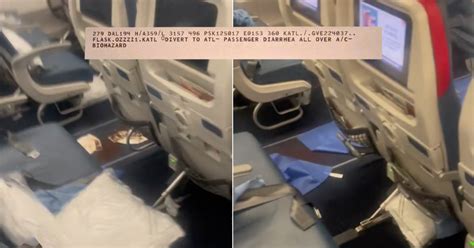
A passenger’s initial excitement over a complimentary flight upgrade quickly turned to dismay after discovering the unsettling reason behind the gesture: the flight was severely underbooked due to numerous cancellations following a nearby train derailment and chemical spill.
The passenger, traveling on a recent United Airlines flight, shared his experience on social media, recounting the initial thrill of receiving a free upgrade only to learn the circumstances were far from ideal. According to his post, the upgrade was offered because the flight was significantly emptier than usual. The reason? A train derailment in a nearby town had resulted in a chemical spill, prompting widespread evacuations and, consequently, mass flight cancellations. The original post quickly went viral, sparking discussions about the ripple effects of such incidents on travel and the potential for hidden consequences behind seemingly positive events.
The passenger, who uses the handle @BaldGuyTravels on social media platforms like TikTok, described his initial reaction to the unexpected upgrade as “stoked.” However, that feeling was short-lived. Upon inquiring about the unusual availability of premium seats, he was informed by a flight attendant about the train derailment and the subsequent mass cancellations.
“I was stoked, I got an upgrade,” the passenger stated in his social media post. “Turns out there was a train derailment in a town near where I was flying from. There was a chemical spill, and basically the whole town had to evacuate. So, tons of people canceled their flights. Score for me, I guess?”
The incident highlights the interconnectedness of various systems and the potential for unforeseen events to disrupt travel plans. Train derailments involving hazardous materials can have far-reaching consequences, impacting not only the immediate vicinity but also broader transportation networks and travel patterns. In this case, the chemical spill led to a mass evacuation, causing numerous travelers to cancel their flights, ultimately resulting in the availability of free upgrades for those who still chose to fly.
The passenger’s social media post also serves as a reminder to consider the context behind seemingly fortunate events. While a free upgrade might initially be perceived as a stroke of luck, it’s important to recognize that such occurrences often stem from underlying circumstances that may be less than desirable. In this instance, the upgrade was a direct consequence of a hazardous event that disrupted the lives of many and underscored the potential risks associated with the transportation of hazardous materials.
The story also underscores the increasing role of social media in disseminating information and shaping public perception. The passenger’s post quickly gained traction, prompting widespread discussions about the incident and its implications. Social media platforms have become powerful tools for travelers to share their experiences, voice their concerns, and hold companies accountable. In this case, the post served as a reminder of the importance of safety and preparedness in the transportation industry and the need to mitigate the risks associated with hazardous materials.
United Airlines has not released an official statement regarding the specific incident. However, the airline has general protocols in place for managing flight disruptions caused by external events. These protocols typically involve providing alternative travel arrangements for affected passengers, offering refunds or credits, and working with local authorities to ensure the safety and well-being of travelers.
The incident raises several important questions about the transportation of hazardous materials and the potential risks associated with such operations. Train derailments involving chemicals can have devastating consequences, not only for the environment but also for human health and safety. It is crucial for transportation companies to implement robust safety measures and emergency response plans to minimize the risk of such incidents and to effectively mitigate their impact when they do occur.
Furthermore, the incident highlights the importance of transparency and communication in the event of a crisis. Travelers have a right to know about potential risks and disruptions that may affect their travel plans. Airlines and other transportation providers should proactively communicate with passengers about such incidents and provide them with accurate and timely information to make informed decisions.
The passenger’s experience also serves as a reminder of the human element in travel. While airlines and airports often focus on efficiency and logistics, it is important to remember that travel is ultimately about people. Travelers have diverse needs and concerns, and it is the responsibility of transportation providers to address those needs and to ensure a safe and comfortable travel experience.
The chemical spill and subsequent flight cancellations also have broader economic implications. Businesses in the affected town may have suffered losses due to the evacuation, and the disruption to travel may have impacted tourism and other industries. Such incidents can have a ripple effect throughout the economy, underscoring the importance of investing in infrastructure and safety measures to prevent such events from occurring.
The incident also raises questions about the role of government regulation in ensuring the safe transportation of hazardous materials. Government agencies have a responsibility to oversee the transportation industry and to enforce regulations that protect the environment and public health. It is crucial for these agencies to stay abreast of emerging risks and to adapt regulations accordingly to ensure the safety and security of the transportation system.
In conclusion, the passenger’s experience with the unexpected flight upgrade serves as a reminder of the complex and interconnected nature of travel and the potential for unforeseen events to disrupt even the most carefully laid plans. The incident highlights the importance of safety, transparency, and communication in the transportation industry, as well as the need for robust emergency response plans and government regulation to protect the environment and public health. The story also underscores the human element in travel and the responsibility of transportation providers to address the needs and concerns of their passengers. While the passenger ultimately benefited from the situation with a free upgrade, the circumstances surrounding the event serve as a sobering reminder of the potential risks associated with the transportation of hazardous materials and the importance of preparedness and prevention. The long-term effects of the chemical spill on the environment and the local community remain to be seen, but the incident serves as a valuable lesson in the importance of safety and responsibility in the transportation industry. The incident also highlights the power of social media in disseminating information and shaping public perception, as the passenger’s post quickly gained traction and sparked widespread discussions about the incident and its implications.
Frequently Asked Questions (FAQs)
1. What caused the flight to be underbooked, leading to the free upgrade?
The flight was underbooked due to a train derailment in a nearby town, which resulted in a chemical spill and subsequent mass evacuation. This led to numerous passengers canceling their flights, creating unexpected availability on the flight. “Turns out there was a train derailment in a town near where I was flying from. There was a chemical spill, and basically the whole town had to evacuate. So, tons of people canceled their flights,” the passenger shared on social media.
2. How did the passenger find out about the reason for the upgrade?
Initially excited about the upgrade, the passenger inquired with a flight attendant about the unusual availability of premium seats. The flight attendant informed him about the train derailment and the resulting mass cancellations due to the chemical spill and evacuation. This underscores the importance of communication from airlines during unexpected disruptions.
3. What implications does this incident have for the transportation of hazardous materials?
The incident highlights the potential risks associated with the transportation of hazardous materials and the need for robust safety measures and emergency response plans. Train derailments involving chemicals can have devastating consequences for the environment, human health, and the economy. It emphasizes the necessity for transportation companies to prioritize safety and implement protocols to minimize the risk of such incidents, as well as effectively mitigate their impact when they occur.
4. What role does social media play in disseminating information about such incidents?
Social media plays a significant role in disseminating information and shaping public perception. The passenger’s post quickly gained traction, prompting widespread discussions about the incident and its implications. Social media platforms have become powerful tools for travelers to share their experiences, voice their concerns, and hold companies accountable. The post served as a reminder of the importance of safety and preparedness in the transportation industry.
5. What are the potential long-term consequences of the chemical spill on the affected community?
The long-term consequences of the chemical spill could include environmental damage, health problems for residents, and economic losses for businesses in the affected town. The evacuation itself disrupts lives and livelihoods, and the cleanup process can be lengthy and costly. Furthermore, there may be lingering concerns about the safety of the area, potentially impacting tourism and property values. Government and environmental agencies will need to conduct thorough assessments and implement remediation efforts to address these potential long-term effects.
Expanded Context and Analysis
The incident involving the United Airlines passenger and the unexpected flight upgrade reveals a complex interplay of factors, ranging from the transportation of hazardous materials to the role of social media in shaping public perception. Beyond the immediate inconvenience of flight cancellations and the fortunate upgrade for one passenger, the event underscores the broader societal implications of infrastructure vulnerabilities and the interconnectedness of various systems.
The Hazardous Materials Transportation Challenge
The transportation of hazardous materials, also known as hazmat, is a critical component of modern economies. These materials are essential for various industries, including manufacturing, agriculture, healthcare, and energy. However, their transportation poses significant risks to the environment, public health, and safety. Hazmat includes a wide range of substances, such as flammable liquids, corrosive materials, toxic gases, and radioactive materials.
The U.S. Department of Transportation (DOT) regulates the transportation of hazardous materials through its Pipeline and Hazardous Materials Safety Administration (PHMSA). PHMSA establishes regulations for packaging, labeling, handling, and transportation of hazmat by all modes of transportation, including rail, highway, air, and water. These regulations are designed to minimize the risk of accidents and incidents involving hazmat and to ensure that emergency responders are adequately prepared to handle such events.
Despite these regulations, accidents involving hazmat do occur, as evidenced by the train derailment in the town near the airport. These incidents can have devastating consequences, including explosions, fires, chemical releases, and environmental contamination. The severity of the consequences depends on the type and quantity of hazmat involved, the location of the incident, and the effectiveness of the emergency response.
The incident serves as a reminder of the need for continuous improvement in the safety and security of hazmat transportation. This includes investing in infrastructure improvements, such as upgrading rail lines and improving tank car designs. It also includes enhancing training and education for hazmat employees and emergency responders. Furthermore, it requires strengthening oversight and enforcement of hazmat regulations.
The Ripple Effects of Infrastructure Failures
The train derailment and chemical spill had a cascading effect on the local community and the surrounding region. The immediate impact was the mass evacuation of the town, which disrupted the lives of thousands of residents. Businesses were forced to close, schools were shut down, and public services were suspended. The evacuation also placed a strain on local resources, such as emergency shelters and transportation services.
The flight cancellations were a direct consequence of the evacuation. Many travelers were unable to reach the airport due to road closures or concerns about exposure to the chemical spill. Others simply chose to cancel their flights out of an abundance of caution. This disruption to air travel had a ripple effect on the broader transportation network, affecting connecting flights and causing delays for passengers across the country.
The economic impact of the incident could be significant. Businesses in the affected town may have suffered substantial losses due to the evacuation and the disruption to commerce. The tourism industry may also have been affected, as travelers may have avoided the region due to concerns about safety. Furthermore, the cleanup costs associated with the chemical spill could be substantial, potentially straining local and state budgets.
The incident highlights the vulnerability of modern societies to infrastructure failures. A single event, such as a train derailment, can have far-reaching consequences, disrupting lives, damaging the environment, and harming the economy. It underscores the importance of investing in infrastructure resilience and redundancy to minimize the impact of such events.
The Power of Social Media in Crisis Communication
The passenger’s social media post played a significant role in disseminating information about the incident and shaping public perception. The post quickly went viral, reaching millions of people around the world. This demonstrates the power of social media as a tool for crisis communication.
In the past, news about such incidents would have been filtered through traditional media outlets, such as newspapers, television, and radio. However, social media has democratized the flow of information, allowing individuals to share their experiences directly with the public. This can be both a blessing and a curse. On the one hand, it allows for the rapid dissemination of information, which can be critical in emergency situations. On the other hand, it can also lead to the spread of misinformation and rumors, which can exacerbate the situation.
In this case, the passenger’s post provided a firsthand account of the incident, offering insights that might not have been available through traditional media channels. The post also sparked a broader conversation about the transportation of hazardous materials and the potential risks associated with such operations. This demonstrates the potential of social media to raise awareness about important issues and to hold companies and governments accountable.
However, it is also important to recognize the limitations of social media as a source of information. Social media posts are often subjective and may not always be accurate. It is essential to verify information from social media sources before drawing conclusions or taking action.
Ethical Considerations and Corporate Responsibility
The incident raises ethical questions about the responsibilities of airlines and other transportation providers in the event of a crisis. Airlines have a duty to provide safe and reliable transportation to their passengers. This includes taking reasonable steps to mitigate the risk of accidents and incidents, as well as providing prompt and accurate information to passengers in the event of a disruption.
In this case, United Airlines did not release an official statement regarding the specific incident. However, the airline has general protocols in place for managing flight disruptions caused by external events. These protocols typically involve providing alternative travel arrangements for affected passengers, offering refunds or credits, and working with local authorities to ensure the safety and well-being of travelers.
Some might argue that United Airlines should have been more proactive in communicating with passengers about the train derailment and the potential impact on their flights. Others might argue that the airline acted responsibly by following its established protocols and focusing on ensuring the safety of its passengers.
Ultimately, the question of corporate responsibility is a complex one that depends on the specific circumstances of each case. However, it is clear that airlines and other transportation providers have a duty to act ethically and responsibly in the event of a crisis. This includes providing prompt and accurate information to passengers, taking reasonable steps to mitigate the risk of harm, and working with local authorities to ensure the safety and well-being of the community.
The Future of Transportation Safety
The incident serves as a wake-up call for the transportation industry and government regulators. It highlights the need for a renewed focus on safety and security, as well as a commitment to investing in infrastructure resilience and redundancy.
In the future, transportation systems will need to be more resilient to a variety of threats, including natural disasters, cyberattacks, and terrorist incidents. This will require a multi-faceted approach that includes strengthening physical security, enhancing cybersecurity, and improving emergency response capabilities.
It will also require a greater emphasis on collaboration and coordination among government agencies, transportation providers, and the private sector. By working together, these stakeholders can develop more effective strategies for mitigating risks and ensuring the safety and security of the transportation system.
Furthermore, it is essential to continue investing in research and development to identify and address emerging threats. This includes developing new technologies for detecting and preventing accidents, as well as improving emergency response capabilities.
Finally, it is important to remember that transportation safety is a shared responsibility. Every individual has a role to play in ensuring the safety and security of the transportation system. This includes following safety regulations, reporting suspicious activity, and being prepared to respond in the event of an emergency. The passenger’s seemingly fortunate upgrade stemming from unfortunate circumstances underscores this shared responsibility.









